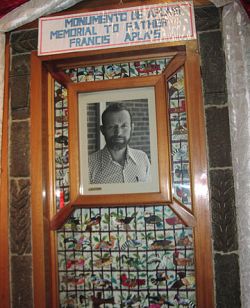A Pilgrimage and Retreat in Guatemala: Jan. 14-25, 2008

by Father James E. Flynn SANTIAGO ATITLAN, Guatemala — On Jan. 20, 2008, my 20 companion priests and deacons were concelebrating Mass in the 16th Century church of Santiago Atitlan, Guatemala. It’s a beautiful but very poor town situated on a gorgeous lake (Atitlan) and tucked between three shapely and active volcanoes. After Communion of the Mass, I returned to my place in the first pew, sat down, and to my delight several young children right behind me began to feel the bald spot on my head. I guess they wondered why my hair was worn off. And they also gently rubbed their little hands through my short and gray hair, wondering again why my hair was gray – not too usual for the Mayan Indigenous males in this gorgeous village. Those children rubbing my head certainly changed my prayer that morning after Communion. I don’t know how my Communion could have been much better: feeling the touches of small children with whom I could not communicate since I couldn’t speak their native Mayan language. Nevertheless, I felt in such communion with those members of the Body of Christ. My fellow companions and I were in Santiago Atitlan because the town is soaked with the blood of so many martyrs – about 300 people killed in the past 25-30 years, mostly by the Guatemalan army. One of their prominent martyrs was their pastor, Fr. Stanley Rother, a missionary priest from Oklahoma City. He was assassinated on July 29, 1982, in the parish house. Unknown assassins tried to drag him out of the house to torture him, but as he resisted they killed him. His blood stains the wall of the room where he was martyred. Fr. Rother was affectionately called Padre Francisco, or Padre "Aplas" in their language – Mayans couldn’t pronounce "Stanley." He served the community for 20 years and was so beloved by parishioners that when he was martyred they asked that his heart be buried in their church. The "shrine" holding his heart is dearly revered by the people there. I have been in Santiago Atitlan a number of times, and over the years the people had listed in the form of a cross on the wall above his heart the names of hundreds of people who had also been martyred by the Guatemalan military – from the late ‘70s to the early ‘90s. My companions and I spent some time and prayer together at the shrine of Padre Aplas’ heart. We also visited a place just out of town where on Dec. 2, 1990, the army killed 13 people, including several children – at point-blank range. In Guatemala City we visited the home of Bishop Juan Gerardi. On April 26, 1998, some death-squad members of the Guatemalan military entered his home, and martyred Bishop Gerardi, brutally crushing his head with concrete blocks. Two days before in the packed national Cathedral in Guatemala City Bishop Gerardi gave a report from the Catholic Church to the nation on the deaths of more than 200,000 Guatemalans during the years of so much violence. The Church Report attributed over 90% of those deaths to the Guatemalan army, about 8% by various guerrilla forces, and the remainder unknown. During those years the army conducted a brutal campaign in small villages in the mountains against Indigenous Mayans (over 60% of the population of Guatemala). The army accused people of being "subversives" (aka "communists"), though most of the Mayans knew little of any of that. It was a campaign conducted by the right-wing dictators of Guatemala and the army, a campaign adapted from Mao-Tse Dung "drain the sea to swallow the fish." More than 2 million people fled Guatemala, mostly into Southern Mexico, though some came to the U.S. During those years various Guatemalan dictators were completely supported by U.S. governments. It was during those awful years of terror that a friend of mine from Kentucky, Sister Diana Ortiz, O.S.U. was kidnapped, tortured and miraculously freed (long story). It happened on Nov. 2, 1989. She was praying in the garden of a Retreat Center, when 3 Guatemalans kidnapped her, took her to a military post and tortured her brutally. When she was discovered as missing, her companion Sisters called the Motherhouse in Kentucky, and immediately began a phone-calling operation to all Kentucky Congresspersons. After two days of torture, someone from the U.S. Embassy, named "Alejandro," came to the place of her torture, and demanded that the kidnappers release her. Sr. Diana’s search since then has been to find out who "Alejandro" was/is, and to find out how someone from the U.S. Embassy knew where the torture chambers were, someone whom she attests spoke Spanish with a "gringo" accent. Guatemala is a land soaked in the blood of so many martyrs: a bishop, many priests and nuns, catechists, religion teachers and community leaders. In 1982 the killing and terror against the Church was so great that the whole diocese of Quiche closed all its churches, and all priests and nuns had to leave. Some Guatemalans told us that they put their Bibles in plastic bags, dug a hole in the ground, and buried them because if the military saw Bibles in their huts they would be killed – accused of being "subversives." See Part II of this article in the next issue of the Intermountain Catholic
© Copyright 2025 The Diocese of Salt Lake City. All rights reserved.

Stay Connected With Us